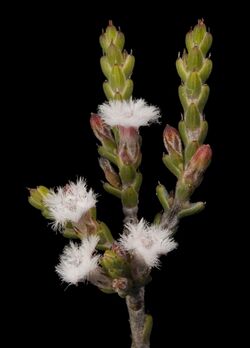Biology:Leucopogon tamminensis
| Leucopogon tamminensis | |
|---|---|

| |
| Leucopogon tamminensis var. australis | |
| Scientific classification | |
| Kingdom: | Plantae |
| Clade: | Tracheophytes |
| Clade: | Angiosperms |
| Clade: | Eudicots |
| Clade: | Asterids |
| Order: | Ericales |
| Family: | Ericaceae |
| Genus: | Leucopogon |
| Species: | L. tamminensis
|
| Binomial name | |
| Leucopogon tamminensis E.Pritz.[1]
| |
| Synonyms[1] | |
|
Styphelia tamminensis (E.Pritz.) Sleumer | |
Leucopogon tamminensis is a species of flowering plant in the heath family Ericaceae and is endemic to the southwest of Western Australia. It is a slender shrub with many branches, overlapping triangular to egg-shaped leaves and white, tube-shaped flower arranged singly in upper leaf axils.
Description
Leucopogon tamminensis is a slender, much-branched undershrub that typically grows to a height of 30–60 cm (12–24 in). Its leaves are sessile, overlap each other and are triangular to egg-shaped, 1.8–2.8 mm (0.071–0.110 in) long and 1.2–1.9 mm (0.047–0.075 in) wide. The leaves are thick and leathery, the upper surface smooth and the lower surface with five to seven thick, parallel ribs. The flowers are arranged singly in upper leaf axils with lance-shaped bracts and broadly egg-shaped bracteoles about 1.5 mm (0.059 in) long. The sepals are 2.3–2.9 mm (0.091–0.114 in) long with reddish-brown tips, and the petals white and joined at the base, forming a cylindrical tube about 50% longer than the sepals, with broadly lance-shaped lobes that are bearded inside.[2]
Taxonomy
Leucopogon tamminensis was first formally described in 1904 by Ernst Georg Pritzel in Botanische Jahrbücher für Systematik, Pflanzengeschichte und Pflanzengeographie from a specimen found on sand-dunes near Tammin.[3][4] The specific epithet, (tamminensis) means "native of Tammin".[5]
In the same journal, Pritzel described the variety australis, and the name, and that of the autonym are accepted by the Australian Plant Census:
Distribution
This leucopogon is found in the Avon Wheatbelt and Esperance Plains IBRA Regions in the south-west of Western Australia.[8]
Conservation status
Leucopogon tamminensis (as Styphelia tamminensis) is listed as "Priority Two" by the Western Australian Government Department of Biodiversity, Conservation and Attractions,[8] meaning that it is poorly known and from only one or a few locations.[9]
References
- ↑ 1.0 1.1 "Leucopogon tamminensis". https://biodiversity.org.au/nsl/services/apc-format/display/68160. Retrieved 2 June 2023.
- ↑ Strid, Arne K. (1986). "New Species of Leucopogon and Conostephium (Epacridaceae) from SW Australia.". Willdenowia 16: 175–177. https://www.jstor.org/stable/3996314. Retrieved 2 June 2023.
- ↑ "Leucopogon tamminensis". APNI. https://biodiversity.org.au/boa/instance/apni/477136. Retrieved 2 June 2015.
- ↑ Pritzel, Ernst G. (1904). "Fragmenta Phytographiae Australiae occidentalis. Beitrage zur Kenntnis der Pflanzen Westaustraliens, ihrer Verbreitung und ihrer Lebensverhaltnisse.". Botanische Jahrbücher für Systematik, Pflanzengeschichte und Pflanzengeographie 35 (2–3): 479. https://www.biodiversitylibrary.org/page/126950#page/508/mode/1up. Retrieved 2 June 2023.
- ↑ Sharr, Francis Aubi; George, Alex (2019). Western Australian Plant Names and Their Meanings (3rd ed.). Kardinya, WA: Four Gables Press. p. 320. ISBN 9780958034180.
- ↑ "Leucopogon tamminensis var. australis". https://biodiversity.org.au/nsl/services/apc-format/display/68274. Retrieved 2 June 2023.
- ↑ "Leucopogon tamminensis var. tamminensis". https://biodiversity.org.au/nsl/services/apc-format/display/68288. Retrieved 2 June 2023.
- ↑ 8.0 8.1 "Styphelia tamminensis". FloraBase. Western Australian Government Department of Parks and Wildlife. https://florabase.dpaw.wa.gov.au/browse/profile/49828.
- ↑ "Conservation codes for Western Australian Flora and Fauna". Government of Western Australia Department of Parks and Wildlife. https://www.dpaw.wa.gov.au/images/documents/plants-animals/threatened-species/Listings/Conservation%20code%20definitions.pdf. Retrieved 2 June 2023.
External links
Wikidata ☰ Q17241663 entry
 |


